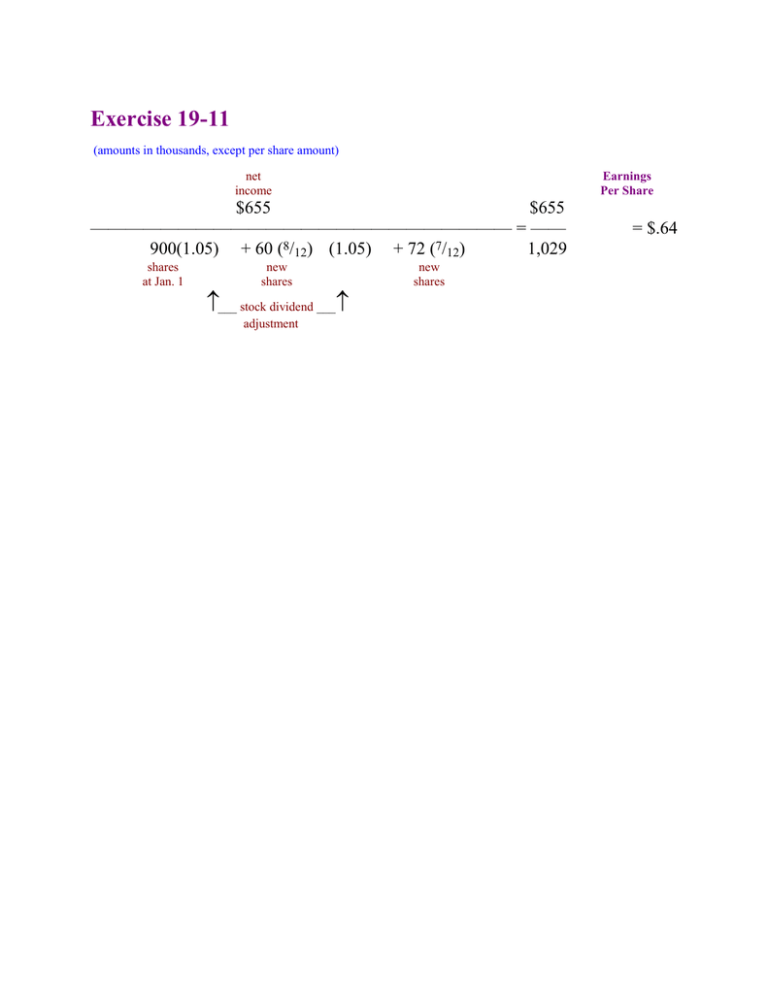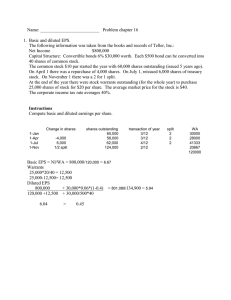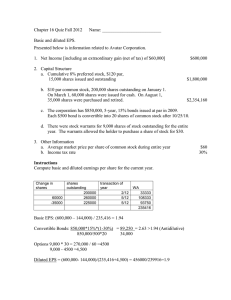Chapter 19 EPS.docx
advertisement

Exercise 19-11 (amounts in thousands, except per share amount) net income Earnings Per Share $655 $655 ———————————————————————— = —— 900(1.05) + 60 (8/12) (1.05) + 72 (7/12) 1,029 shares at Jan. 1 new shares ___ stock dividend ___ adjustment new shares = $.64 Problem 19-10 The options issued in 2004 are not considered when calculating 2006 EPS because the exercise price ($33) is not less than the 2006 average market price of $32 (although they would have been considered when calculating 2004 or 2005 EPS if the average price those years had been more than $33). The options issued in 2006 do not affect the calculation of 2006 EPS because they were issued at December 31. Options are assumed exercised at the beginning of the year or when granted, whichever is later — when granted, in this case. So, the fraction of the year the shares are assumed outstanding is 0/12, meaning no increase in the weighted-average shares. The options issued in 2005 are considered exercised for 8,000 shares when calculating 2006 EPS because the exercise price ($24) is less than the 2006 average market price of $32. Treasury shares are assumed repurchased at the average price for diluted EPS: 8,000 x $24 $192,000 ÷ $32 6,000 shares (exercise price) (average market price) shares Problem 19-10 (concluded) (amounts in thousands, except per share amounts) Basic EPS net income preferred dividends $2,100 – $75 $2,025 ——————————————————————————— = —— = $3.00 600(1.04) + 60 (10/12) (1.04) – 2 (6/12) 675 shares at Jan. 1 new shares shares retired ___ stock dividend ___ adjustment Diluted EPS net income preferred dividends after-tax interest savings $2,100 – $75 + $80 – 40%($80) $2,073 ———————————————————————————— = — = $2.86 600(1.04) + 60(10/12) (1.04) – 2 (6/12) + (8 – 6) + 23* + 24** 724 shares at Jan. 1 new shares shares retired exercise of options contingent shares conversion of bonds ___ stock dividend ___ adjustment * The contingently issuable shares are considered issued when calculating diluted EPS because the condition for issuance (Merrill net income > $500,000) currently is being met. ** The bonds are considered converted when calculating diluted EPS: 800 bonds x 30 shares = 24,000 shares upon conversion. Interest = $800,000 x 10% = $80,000. Problem 19-11 Requirement 1 (amounts in thousands, except per share amount) Basic EPS: net income preferred dividends $150 – $77 $73 ———————————————— = ——— = 40 40 $1.83 weighted-average shares With conversion of preferred stock (Diluted EPS): net income $150 $150 ———————————————— = ——— = 40 + 20 60 weighted-average shares $2.50 conversion of preferred shares Since the assumed conversion of the convertible preferred stock causes EPS to increase, it is antidilutive and therefore ignored when calculating EPS. Problem 19-11 (concluded) Requirement 2 Basic EPS: net income $150 ————————— 40 = $3.75 weighted-average shares With conversion of bonds: net income after-tax interest savings $150 + $40 – 40% ($40) $174 ———————————————— = ——— = 40 +5 45 weighted-average shares $3.87 conversion of bonds Since the assumed conversion of the convertible bonds causes EPS to increase, it is antidilutive and therefore ignored when calculating EPS. Requirement 3 Since the exercise price is less than average market price, the options are not antidilutive and therefore assumed exercised when calculating diluted EPS. Requirement 4 Since the exercise price is higher than the average market price, the warrants are antidilutive and therefore ignored when calculating diluted EPS. Requirement 5 The 5,000 shares are added to the denominator when calculating diluted EPS since 2006 net income is higher than the conditional amount. Since only the denominator is increased, the effect is not antidilutive. Problem 19-12 (amounts in millions, except per share amounts) Basic EPS net income $560 $560 —————————————————————— = —— = $1.44 400 – 30 (4/12) 390 shares at Jan. 1 new shares Diluted EPS after-tax* interest savings net income $560 + $30 – 40% ($30) $578 —————————————————————— = —— = $1.36 400 – 30 (4/12) + 36 426 shares at Jan. 1 *Interest new shares conversion of bonds on the bonds = $300 million x 10% = $30 million. If the bonds were not outstanding, interest expense would have been $30 million lower, and tax expense would have been 40% x $30 million, or $12 million higher, a net aftertax savings of $18 million. Problem 19-13 (amounts in thousands, except per share amounts) Basic EPS net income preferred dividends – $40* $650 $610 —————————————————————————————————— = ——— = 440 + 16 (3/12) 444 shares new at Jan. 1 shares $1.37 Diluted EPS net income $650 preferred dividends – $40* shares at Jan. 1 new shares preferred dividends + 40* $650 ————————————————————————————————— = ——— = $1.33 440 + 16 (3/12) + (20 – 15**) + 40 489 * 4,000 exercise of options conversion of preferred shares shares x $100 par x 10% = $40,000 **Assumed purchase of treasury shares 20,000 shares x $30 (exercise price) $600,000 ÷ $40 (average market price) 15,000 shares Problem 19-14 (amounts in millions, except per share amounts) Basic EPS net income preferred dividends $1,476 – $60* $1,416 ——————————————————————————————————————— = ——— $2.27 600 + 72 (4/12) shares at Jan. 1 = 624 new shares Diluted EPS net income preferred dividends after-tax Interest savings $1,476 – $60* + $160 - 40% ($160) shares at Jan. 1 new shares $1,512 ——————————————————————————————————————— = ——— = $2.09 600 + 72 (4/12) + (60 – 40)** + 80 724 exercise of options conversion of bonds *Preferred dividends: 6% x $50 x 20 million shares = $60 million **Computation of Treasury Shares: 60 million x $12 $720 million ÷ $18 40 million shares exercise price proceeds average share price treasury shares






